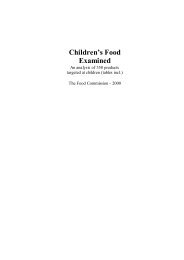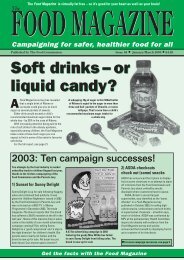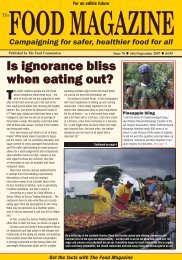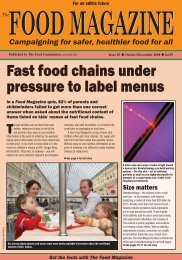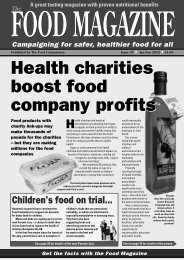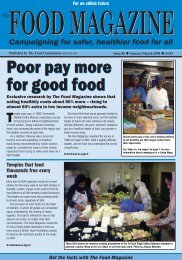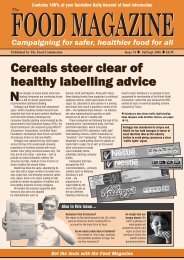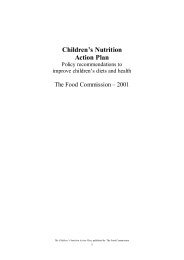Campaigning for safer, healthier food for all - The Food Commission
Campaigning for safer, healthier food for all - The Food Commission
Campaigning for safer, healthier food for all - The Food Commission
Create successful ePaper yourself
Turn your PDF publications into a flip-book with our unique Google optimized e-Paper software.
ackbites<br />
Biscuits use sunblock as ‘natural’ colouring<br />
In a consumer survey published in January, the<br />
government’s <strong>Food</strong> Standards Agency found that<br />
consumers do not gener<strong>all</strong>y trust descriptions<br />
such as ‘real’,<br />
‘original’ and ‘natural’<br />
on <strong>food</strong> labels. No<br />
wonder when products<br />
such as these Jammie<br />
Dodgers (nearly 30% sugar and over 7%<br />
saturated fat) claim to have ‘No artificial<br />
colours’, but list titanium dioxide as a colouring.<br />
If it isn't artificial then it must be natural, we<br />
assume, but just how natural is it to have a<br />
mouthful of titanium dioxide?<br />
<strong>The</strong> answer is that you have to be pretty<br />
unlucky. <strong>The</strong> chemical can be<br />
obtained from a type of beach<br />
sand (rutile sand) and<br />
sometimes occurs in a different<br />
Sweets <strong>for</strong> dummies?<br />
What’s this? A baby’s dummy<br />
that the manufacturer warns is<br />
unsuitable <strong>for</strong> babies? What a<br />
strange anomaly.<br />
With an internal plastic spike<br />
inside this Baby Pop lolly, the<br />
warning is presumably due to the<br />
danger of impalement on ‘sm<strong>all</strong> parts’. But what<br />
about the danger to sm<strong>all</strong> teeth of prolonged<br />
exposure to a sugary sweet while a child is<br />
sucking on this amazing object?<br />
Sadly, UK law seems more concerned with<br />
preventing accidents than preventing disease, so<br />
such products can continue to be sold.<br />
Waitrose: where the lights never say ‘go’?<br />
Our hearty congratulations to the supermarket<br />
chain Waitrose <strong>for</strong> being the first to adopt the<br />
government’s approved traffic light scheme <strong>for</strong><br />
nutrient labelling.<br />
Despite an industry plot to make nutrient<br />
labelling as confusing as possible, with major<br />
companies launching contradictory schemes,<br />
using different nutritional criteria and confusing<br />
colour coding, bars, stars, wheels and blobs,<br />
the <strong>Food</strong> Standards Agency has stuck to its<br />
guns and c<strong>all</strong>ed <strong>for</strong> a consistent and uni<strong>for</strong>m<br />
approach using a simple set of traffic lights<br />
based on the FSA's definitions of low, medium<br />
and high levels of the key nutrients (fat,<br />
saturates, salt and sugars).<br />
Waitrose has launched an FSA-approved<br />
traffic light scheme on its sandwich packs, and<br />
helpfully suggests that this 'can help you<br />
<strong>The</strong> best available?<br />
A ‘healthy option’<br />
from Waitrose, but<br />
still not giving us<br />
the green light.<br />
cryst<strong>all</strong>ine <strong>for</strong>m known as anatase. But even with<br />
a mouthful of rutile sand you would not be getting<br />
pure titanium dioxide. To purify the pigment, you<br />
must refine the ore: this<br />
means using either a<br />
sulphate process, which<br />
uses sulphuric acid as an<br />
extraction agent, or a<br />
chloride process, which uses chlorine. <strong>The</strong>se<br />
processes were first used <strong>for</strong> bulk production of<br />
titanium dioxide less than a century ago.<br />
With highly reflective properties, titanium<br />
dioxide is widely used in paints, plastics and<br />
paper coatings, and as a sunblock ingredient. It<br />
is also strongly oxidative, and is used <strong>for</strong><br />
sterilising building materials and is added to antifouling<br />
coatings. On the label, the manufacturer<br />
of these biscuits ask ‘What makes 'em so<br />
Yummy?’ What indeed?<br />
balance your weekly intake'. It helpfully adds: 'If<br />
you choose a sandwich that is high in<br />
saturated fat one day, you might select one<br />
which is low or medium the next'.<br />
But suppose you wanted to eat a healthy<br />
sandwich every day? We have visited Waitrose<br />
on two occasions to buy a sandwich with <strong>all</strong><br />
the traffic lights set at green.<br />
Alas! We could find not a single sandwich<br />
able to supply a fully healthy snack. Most of the<br />
best ones were let down by excess salt.<br />
Perhaps this will shame the company into<br />
re<strong>for</strong>mulating their products. We have long<br />
argued that best thing about nutrient labelling is<br />
not that it passes responsibility <strong>for</strong> good health<br />
to the consumer but that it exposes the<br />
practices of the producers.<br />
How about an <strong>all</strong>-green sandwich, Waitrose?<br />
And the worst? Tesco's sandwich<br />
declares a hefty 58g fat – but <strong>all</strong> fat<br />
levels get the same green light!<br />
Is green the colour<br />
of money?<br />
A glossy supplement in the magazine Green<br />
Futures, from Jonathon Porritt's group Forum<br />
<strong>for</strong> the Future, is entitled Sausage, Mash and<br />
Sustainability.<br />
It delves into the need to combat obesity,<br />
improve school meals, reduce salt in<br />
processed <strong>food</strong>s and promote local <strong>food</strong><br />
supplies, such as beef from Hampshire farms<br />
into nearby schools.<br />
All very laudable, but there were some odd<br />
extra boxes on some pages, extolling the<br />
virtues of school-meals providers Compass,<br />
Kraft <strong>Food</strong>s (makers of Dairylea Lunchables),<br />
and the promoters of British beef, the Meat<br />
and Livestock <strong>Commission</strong>.<br />
No sign that these were paid-<strong>for</strong><br />
advertisements, just useful in<strong>for</strong>mation to boost<br />
the stories on <strong>healthier</strong> living, it appeared.<br />
Until one got to the back page to find that<br />
the whole supplement had been sponsored by<br />
– yes – Compass, Kraft and the MLC.<br />
And there was a fourth sponsor. You, dear<br />
readers, as tax payers, helped promote these<br />
advertorials with a grant from Defra.<br />
But there is a nice twist to the story. If you<br />
go to the Green Futures website you will be<br />
asked to pay £24 or more to receive the<br />
magazine, including the supplement.<br />
But if you go to Defra's website they have<br />
reproduced the whole thing <strong>for</strong> free!<br />
See www.defra.gov.uk/FARM/sustain/<br />
procurement/pdf/GFreport05.pdf<br />
<strong>for</strong> knowledge<br />
<strong>The</strong> European <strong>Commission</strong> appeared to be<br />
caught unawares by the benzene-in-soft-drinks<br />
scandal (see pages 18 to 19). According to the<br />
online trade magazine BeverageDaily.com, a<br />
letter dated December 2005 and signed by a<br />
<strong>Commission</strong> official stated that the <strong>Commission</strong><br />
'is not aware of any scientific evidence relating<br />
to the <strong>for</strong>mation of benzene' as a result of using<br />
benzoates in soft drinks. It had asked EU member<br />
states to send any details in their possession.<br />
Perhaps the <strong>Commission</strong> staff should have<br />
read an interesting report from the Italian Institute<br />
<strong>for</strong> Health and Consumer Protection.<br />
<strong>The</strong> report states: ‘Added benzoates and<br />
ascorbates might react to <strong>for</strong>m benzene. If<br />
either one of the other were removed, the<br />
benzene might no longer be <strong>for</strong>med.’ It goes on<br />
to list the benzene levels found in various drinks<br />
and juices, helpfully stating whether the samples<br />
had added benzoates.<br />
<strong>The</strong> report also declares in large print on the<br />
front cover that the research was undertaken<br />
<strong>for</strong>… the European <strong>Commission</strong>! And the<br />
document was placed on the <strong>Commission</strong>'s own<br />
research website in 2004.<br />
<strong>Food</strong> Magazine 73 24<br />
Apr/Jun 2006<br />
Thirst



